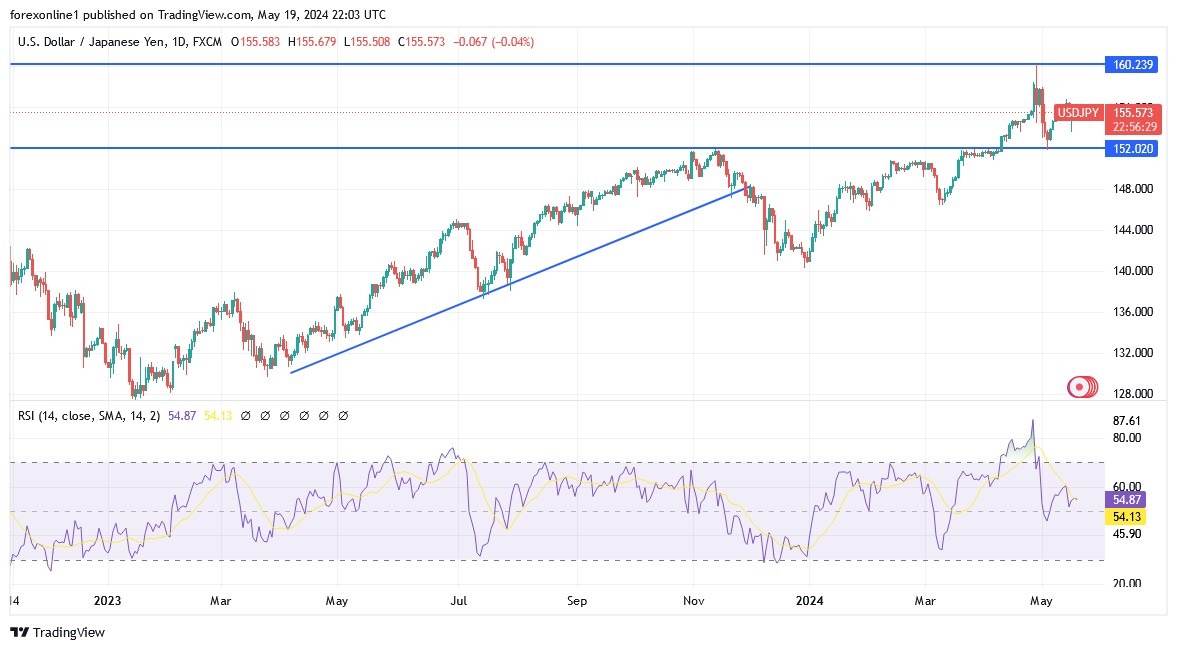- Core inflation in the United States slowed in April for the first time in six months, a small step in the right direction for Federal Reserve officials looking to start cutting interest rates this year.
- As a result, the price of the US dollar against the Japanese yen (USD/JPY) was exposed to selling operations, because of which it started from the level of 156.79 with losses to the support level of 153.60.
- Meanwhile, last week’s trading closing was stable around the level of 155.61 after it was close to the resistance of 156.00, where the discrepancy between the Federal Reserve’s policy remains. Clearly, the US and the Bank of Japan support the control of bulls.
According to the results of the economic calendar, the so-called core US consumer price index, which excludes food and energy costs, rose 0.3 percent compared to March, according to government data released last Wednesday. Compared to last year, it increased by 3.6 percent. Economists believe that the core measure is a better indicator of core inflation than the overall US Consumer Price Index. Figures from the US Bureau of Labor Statistics showed that this measure rose 0.3 percent from the previous month and 3.4 percent from a year ago. Moreover, the Bureau of Labor Statistics added in the report that shelter and gasoline accounted for more than 70 percent of the increase.
Meanwhile, the figures may offer the Fed some hope that US inflation is resuming its downward trend, officials will want to see more readings to gain the confidence they need to start thinking about cutting interest rates. In this regard, Fed Chairman Jerome Powell recently said that the central bank "will need to be patient and let policy do its work," and some policymakers do not expect to cut interest rates at all this year. Commenting on this, Kathy Jones, an analyst at Charles Schwab, said, "It opens the door to a possible cut in US interest rates later in the year." "It will take a few more readings indicating that inflation is falling for the Fed to act."
As a result, US Treasury yields fell, S&P 500 futures rose, and the US dollar weakened. Thus, traders boosted the odds of a US rate cut in September to around 60%.
Overall, the Fed is trying to curb price pressures by weakening demand across the economy. Separate data released last Wednesday showed a slump in US retail sales in April, suggesting that rising borrowing costs and mounting debt are encouraging more caution among consumers. Also, the core CPI rose at an annual rate of 4.1% over the past three months, the slowest since the beginning of the year. In addition to shelter, the CPI advance was again driven by services such as car insurance and medical care. Clothing prices rose at the fastest pace since June 2020.
Shelter prices, the largest category within services, rose 0.4% for the third month. Owners' equivalent rent - a subcategory of shelter, which is the single largest component of the CPI - rose by a similar amount. Furthermore, strong housing costs are a major reason why inflation is refusing to come down, not only in the United States but also in many other developed economies. Excluding housing and energy, service prices rose 0.4% from March, the weakest pace this year, according to Bloomberg calculations. However, central bank governors have stressed the importance of looking at such a measure when assessing the country's inflation path, they calculate it based on a separate index. This measure, known as the personal consumption expenditures price index, does not give as much weight to shelter as the CPI does. Consequently, this is part of the reason why personal consumption expenditures are getting closer to the Fed's 2% target.
Top Forex Brokers
USD/JPY Technical Analysis and Expectations Today:
We still believe that the general trend for the USD/JPY exchange rate may remain the same if the divergence in policies between the US Federal Reserve and the Bank of Japan persists. Currently, the movement towards stronger upward levels will continue until Japanese intervention in the markets occurs to prevent further depreciation of the currency. Technically, the nearest resistance levels for the current trend are 156.30 and 157.80, respectively.
Ready to trade our Forex daily forecast? We’ve shortlisted the best FX trading platform in the industry for you.

